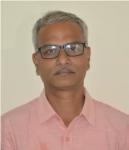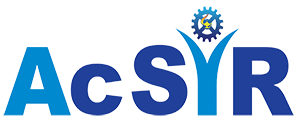
આચાર્ય વૈજ્ વૈજ્ઞાનિક
- shaldar@csmcri.res.in
- 2567760 (Extn. 6320) | Ext: 6320
Research Activities
Molecular identification, pathogenic potential, ecological significance of marine Vibrio.
-|| Research Highlights ||-
-
Scientific papers
S. Haldar, Kalpana H. Mody, Bhavanath Jha. Abundance, diversity and antibiotics resistance pattern of Vibrio spp. in coral ecosystem of Kurusadai island. J. Basic Microbiol., 50: 1-10, 2010.
S. Haldar, S. Chatterjee, K. Kogure, S. Neogi, N. Chowdhury, A. Hinenoya, M. Asakura, S. Yamasaki. Simultaneous detection of Vibrio campbellii, Vibrio harveyi and Vibrio parahaemolyticus by hemolysin gene-based multiplex PCR. Lett. Appl. Microbiol., 50: 146-152, 2010.
S. Haldar, A. Maharajan, S. Chatterjee, S. A. Hunter, N. Chowdhury, A. Hinenoya, M. Asakura, and S. Yamasaki. Identification of Vibrio harveyi as a causative bacterium for a tail rot disease of seabream Sparus aurata from research hatchery located in Malta. Microbiol. Res., 165(8): 639-648, 2010.
S. Haldar, Shruti Chatterjee, Norihiko Sugimoto, Surajit Das, Nityananda Chowdhury, Atsushi Hinenoya, Masahiro Asakura and Shinji Yamasaki. Identification of Vibrio campbellii isolated from diseased farm-shrimps from south India and establishment of its pathogenic potential in an Artemia model. Microbiology-SGM., 157: 179-188, 2011.
S. Haldar, S. Chatterjee, M. Vijayakumaran, Antibacteria effects of some common marine micro algal extracts on pathogenic isolates of Vibrio parahaemolyticus and Vibrio cholera. Seaweed Res Utilization, 31(1 & 2): 213-217, 2009.
S. Haldar, S. Chatterjee, M. Asakura, M. Vijayakumaran, and S. Yamasaki. Isolation of Vibrio parahaemolyticus and Vibrio cholerae (Non-O1 and O139) from moribund shrimp (Penaeus monodon) and experimental challenge study against post larvae and juveniles. Ann. Microbiol., 57: 55-60, 2007.
S. Haldar, B. Dutta, R. Chakrabarty, T. Ramamurthy, 2006. Zoonotic significance of Vibrio cholerae and Vibrio parahaemolyticus isolated from shrimp farm system. Ind. J. Ani. Health, 45 (1):1-8, 2006.
S. Haldar, T. Kannupandi and S. Ravichandran. 2001. Closed Recycling System in aquaculture-Disease preventive, Cost effective Method. Aqua International, 9(8):17-19, 2001.
S. Haldar, Book Review: Pollution control, climate change and Industrial disasters, International Journal of Environmental Studies. 67(6): 965-966, 2010.
A.Maharajan, S. Rajalakshmi, S. Haldar and M. Vijayakumaran. Sub lethal effect of copper on the frequency of electrical conductivity in the muscle tissue of spiny lobster, panulirus homarus (linnaeus, 1758), J. Aqut Biol., 25(1):2010.
M. Kanagasabhapathy, H. Sasaki, S. Haldar, S. Yamasaki and S. Nagata. Antimicrobial activities of marine epibiotic bacteria isolated from brown algae of Japan. Ann. Microbiol., 56: 167-173, 2006.
N. Chowdhury, M. Asakura, S. B. Neogi, A. Hinenoya, S. Haldar, T. Ramamurthy, B.L. Sarkar, S. M. Faruque and S. Yamasaki. Development of simple and rapid PCR-fingerprinting methods for Vibrio cholerae on the basis of geneticdiversity of the superintegron. J. Appl. Microbiol., 109: 304-312, 2010.
Shruti Chatterjee, Masahiro Asakura, Nityananda Chowdhury, Sucharit Basu Neogi, Norihiko Sugimoto, Soumya Haldar, Sharda Prasad Awasthi, Atsushi Hinenoya, Shunji Aoki, Shinji Yamasaki, Capsaicin, a potential inhibitor of cholera toxin production inVibrio cholerae. FEMS Microbiol. Lett., 306(1): 54-60, 2010.
S. Chatterjee, S. Haldar, M. Asakura, S. Yamasaki, and T. Balasubramanian. Molecular identification and phylogenetic status of marine Bacillus associated with coral sediment, showing antibacterial effects against human pathogens. Ann. Microbiol., 58: 309-312, 2008.
Yogesh, S. Haldar, P. Paul, A. Bhattacharya.Polysulfone-Azo CompositeMembrane: New Preparative Approach, Importance in Bactericidal and Biofilm Inhibition Activities. J. Appl. Polymer Sci.,115: 3710–3715, 2010.
Neogi, Sucharit; Chowdhury, N; Asakura, M; Hinenoya, A; S. Haldar,; Suleiman, Saidi; Kogure, Kazuhiro; Lara, Ruben; Yamasaki, Shinji, A highly sensitive and specific multiplex PCR assay for simultaneous detection of Vibrio cholerae, Vibrio parahaemolyticus and Vibrio vulnificus. Lett. Appl. Microbiol. 51(3): 293-300, 2010.
Mandal, S.K., Mantri, V. A., Haldar, S., Eswaran, K., Ganesan, M. Invasion potential of Kappaphycus alvarezii on coral at Kurusadai island, Gulf of Mannar, India. Algae. 25(4): 205-216, 2010.
Shafeeuulla Khan, M. A., Singh, A., Haldar, S., Ganguly, B., Can nitrilotriacetic acid (NTA) act as a habit modifier for rock salt crystal? An answer from computational and experimental studies. Crystal Growth Design. 11:1675-1682, 2011.
Report submitted
G.A. Thivakaran, Soumya Haldar, R. Rajasekaran, B. Muthuraman and Lomesh Bhrambhat. January 2005. Marine environmental monitoring of Gujarat Adani port, Kachchh, Gujarat. (Seasonal report Submitted to Gujarat Adani port Ltd.,(GAPL), Mundra).
List of new gene sequencing and details of submission to NCBI/DDBJ Gene Bank (http://www.ncbi.nlm.nih.gov/BLAST):
Partial 16S rDNA sequence for identification of some marine Bacillus sp. and submission to DDBJ/NCBI gene bank with following public accession numbers:
AB244179, AB244180, AB244181, AB244182, AB244183, AB244184, AB244185, AB244186, AB244187, AB244188
Submission of AB286649 (Bacillus Licheniformis), AB286650 (Bacillus subtilis) andAB286651(Bacillus cereus) to DDBJ/NCBI gene bank.
DNA sequence of complete hemolysin gene of 4 marine V. campbellii strains and submitted to DDBJ/NCBI gene bank for public access with following accession numbers:
AB271109, AB271110, AB271111, AB271112
Paper read before international conference
In gene sequencing and diversity:
Soumya Haldar, M. Asakura, Shruti Chatterjee, S. Yamasaki, Isolation, Characterizations of Vibrio campbellii strains isolated from diseased shrimp farm in India. 80th Meetings of Japanese Society for Microbiology, 26-29th March, 2007.
K. Fujihara, M. Asakura, Soumya Haldar, S. Lei, T. Ramamurthy, B.L. Sarkar, S.M. Faruque, G.B. Nair, Y. Takeda, S. Yamasaki, Genetic diversity of super-integron in various Vibrio cholerae strains. Vibrio, 2005, Ghent, Belgium, pp. 98-99.
S. Yamasaki1, S. Chatterjee, M. Asakura1, N. Chowdhury, S. B. Neogi, N. Sugimoto, Soumya Haldar, S. P. Awasthi1, A. Hinenoya1, S. Aoki. Red Chili Contains Compounds that Inhibit Cholera Toxin Production in Vibrio cholerae. In pollution monitoring and remote sensing application.
Soumya Haldar and Vijayakumaran M., 2002. Application of GIS techniques to study the distribution of heavy metals (Cu, Zn and Fe) in different parts of Avicennia and Rhizophora plants in the Sundarban mangrove, West Bengal. International Symposium on Resources and Environmental Monitoring. Conducted by ISPRS TC-VII & Indian Society of Remote Sensing. Hydrabad.
Paper read before national conference (on GIS application):
Soumya Haldar, Rajlakshmi, S.and Vijayakumaran, M.,2003. Application of GIS for the site selection of shrimp farming. Paper presented as resource person at the National Institute of Rural Development in the Consultative workshop for Information and Communication Technology (ICT) Intervention for Rural Development. Hydrabad. 25-26th February 2003
Scientific popular articles:
Soumya Haldar, Shy Sea Monster, Science Reporter, July 2002. pp. 56-57.
Soumya Haldar, 2002, IRS-P4 (OCEANSAT) -A boon in ocean study. Sashiyana, 10(2), pp. 5-6.
- Coral-bacterial interaction, Environmental/Marine microbiology, Marine Environmental Impact Assessment.
- Molecular identification, pathogenic potential, ecological significance of marine Vibrio.
- Others













